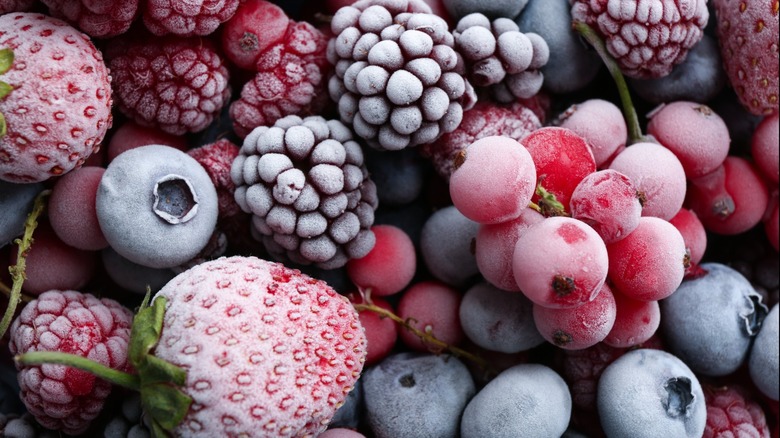
Nothing beats the burst of flavor from a ripe, juicy peach or a handful of sweet summer berries. But when the seasons change, keeping that fresh-from-the-orchard taste can feel like chasing a fading sunset. Freezing fruits is a fantastic way to lock in that vibrant flavor for months, but if you’ve ever ended up with mushy, tasteless blobs instead of delicious fruit, you know it’s not as simple as tossing them in the freezer. I learned this the hard way when I tried freezing strawberries for the first time—only to find a sad, watery mess when I thawed them. Through trial and error (and a lot of research), I’ve uncovered the secrets to freezing fruits without sacrificing their taste or texture. In this guide, I’ll walk you through every step, share expert tips, and sprinkle in some personal stories to help you preserve your favorite fruits perfectly. Whether you’re a busy parent stocking up for smoothies or a foodie aiming to capture summer’s essence, this post has you covered.
Why Freeze Fruits? The Benefits of Locking in Flavor
Freezing fruits isn’t just about saving extras from a bumper harvest; it’s a game-changer for convenience, nutrition, and flavor. According to the USDA, frozen fruits retain most of their vitamins and antioxidants, making them a nutritious choice year-round. Imagine pulling out perfectly sweet blueberries for pancakes in the dead of winter or blending frozen mango for a tropical smoothie when snow’s piling up outside. Freezing also cuts down on food waste—those overripe bananas or berries you can’t eat in time? They’re prime candidates for the freezer. Plus, it’s budget-friendly. Buying in-season fruits at their peak (and often at lower prices) and freezing them means you’re not shelling out for overpriced, out-of-season produce. But to keep that fresh-picked taste, you need to freeze them right. Let’s dive into the how-to.
Choosing the Right Fruits for Freezing
Not all fruits freeze equally well. Some, like berries and cherries, are freezer superstars, while others, like watermelon, can turn into a soggy disaster. My first attempt at freezing grapes was a revelation—those little frozen gems became my go-to summer snack—but I wasn’t so lucky with cantaloupe. Here’s a quick rundown of fruits that freeze well and those that don’t, based on insights from The Kitchn:
- Best for Freezing: Berries (strawberries, blueberries, raspberries), cherries, bananas, mangoes, pineapples, peaches, and grapes. These fruits have lower water content or firm textures that hold up well.
- Tricky to Freeze: Watermelon, citrus fruits (oranges, lemons), and apples. High water content can make them mushy, but they can work if prepared properly (more on that later).
Before freezing, always pick ripe, high-quality fruits. Overripe or underripe fruits won’t magically improve in the freezer. Check for blemishes or mold, and give them a good rinse. The FDA recommends washing fruits under running water to remove dirt and bacteria, even if you plan to peel them.
Preparation: The Key to Flavorful Frozen Fruits
Preparation is where the magic happens. Skipping these steps can lead to flavorless, freezer-burned fruit. Here’s how to prep like a pro:
Wash and Dry Thoroughly
Start by gently washing your fruits to remove any pesticides or debris. For delicate berries, use a colander and a light rinse. Pat them dry with a clean towel or let them air-dry completely. Wet fruit can form ice crystals, which ruin texture and dilute flavor. I learned this when I rushed through drying strawberries and ended up with a clumpy mess.
Peel, Pit, or Core as Needed
For fruits like peaches, mangoes, or apples, peel and remove pits or cores. Slice them into uniform pieces for even freezing. Smaller pieces freeze faster, preserving flavor better, according to Food Network. For example, I slice peaches into wedges and bananas into coins for easy blending or snacking.
Treat to Prevent Browning
Some fruits, like apples and pears, brown quickly when exposed to air. To prevent this, soak them in a solution of water and lemon juice (1 tablespoon lemon juice per cup of water) for a few minutes. This tip from Bon Appétit keeps your fruit looking and tasting fresh.
Flash-Freezing for Perfect Texture
Flash-freezing is a game-changer. Spread your fruit pieces in a single layer on a parchment-lined baking sheet and freeze for 1–2 hours. This prevents them from sticking together in a solid block. I discovered this trick when I froze blueberries individually, making it easy to grab a handful for muffins without chiseling them apart.
Freezing Methods: Dry Pack vs. Syrup Pack
There are two main ways to freeze fruits: dry pack and syrup pack. Each has its perks, depending on how you plan to use the fruit.
Dry Pack: Simple and Versatile
The dry pack method involves freezing fruit without added liquid. It’s ideal for smoothies, baking, or snacking. After flash-freezing, transfer the fruit to freezer-safe bags or containers, removing as much air as possible to prevent freezer burn. I love this method for berries and grapes because it keeps their natural flavor intact. According to Epicurious, vacuum-sealing bags work best, but if you’re using regular freezer bags, press out the air before sealing.
Syrup Pack: Sweet and Juicy
For fruits like peaches or cherries, a syrup pack can enhance flavor and texture. Make a simple syrup by dissolving sugar in water (a 1:1 ratio works well) and let it cool. Pour the syrup over the fruit in a freezer-safe container, leaving some headspace for expansion. This method, recommended by Serious Eats, is perfect for desserts or compotes, as the syrup keeps the fruit juicy. I tried this with peaches last summer, and they tasted like a warm hug when I thawed them for a cobbler.
Sugar Pack: A Middle Ground
A sugar pack is a hybrid approach. Sprinkle sugar over the fruit (about ½ cup per pound) and let it sit until the fruit releases its juices. Pack the fruit and juice into containers. This works well for strawberries, which can lose sweetness in the freezer. I’ve used this method for strawberry jam, and the results were divine.
Comparison Table: Freezing Methods at a Glance
Choosing the Best Freezing Method for Your Fruits
| Method | Best For | Pros | Cons | Best Fruits |
|---|---|---|---|---|
| Dry Pack | Smoothies, baking, snacking | Preserves natural flavor, no added sugar | Can dry out if not sealed properly | Berries, bananas, grapes |
| Syrup Pack | Desserts, compotes | Keeps fruit juicy, enhances sweetness | Adds sugar, requires prep time | Peaches, cherries, plums |
| Sugar Pack | Jams, pies, sauces | Balances flavor, prevents browning | Adds sugar, can be sticky | Strawberries, raspberries, mangoes |
This table should help you decide which method suits your needs. For versatility, I lean toward dry packing, but syrup packs are a treat for special recipes.
Storing Frozen Fruits: Avoiding Freezer Burn
Freezer burn is the enemy of flavor. It happens when air reaches the fruit, causing it to dry out and taste off. To avoid this:
- Use Airtight Containers: Freezer-safe bags, vacuum-sealed pouches, or glass containers with tight lids work best. Good Housekeeping suggests double-bagging delicate fruits like raspberries.
- Label Everything: Write the fruit type and date on the container. Most fruits stay good for 8–12 months, per the USDA.
- Keep Your Freezer Cold: Set your freezer to 0°F (-18°C) or lower. I learned this lesson when my old freezer fluctuated, turning my frozen mangoes into a tasteless mush.
I once forgot to label a bag of frozen fruit and spent weeks wondering if it was mango or pineapple. Trust me, labeling saves headaches.
Thawing and Using Frozen Fruits
Thawing is where many people go wrong, ending up with soggy fruit. The key is patience. For the best texture, thaw fruits in the fridge overnight. If you’re in a hurry, place the sealed bag in cold water for faster thawing, as advised by Taste of Home. For smoothies or cooking, you can often use frozen fruit directly—no thawing needed. I toss frozen berries straight into my blender for smoothies, and they come out perfectly creamy.
When using frozen fruits in baking, like for pies or muffins, add them frozen to prevent excess juice from ruining the batter. My go-to blueberry muffin recipe tastes just as good with frozen berries as fresh ones, thanks to this trick.
Creative Ways to Use Frozen Fruits
Frozen fruits are incredibly versatile. Here are some ideas to spark your creativity:
- Smoothies: Blend frozen bananas, berries, or mangoes with yogurt or milk for a quick breakfast. The frozen texture adds creaminess without ice.
- Desserts: Use syrup-packed peaches for cobblers or sugar-packed strawberries for homemade ice cream.
- Snacks: Frozen grapes or pineapple chunks are like mini popsicles—perfect for kids or hot summer days.
- Sauces and Jams: Cook down frozen berries with a bit of sugar for a quick jam or sauce to drizzle over pancakes.
Last winter, I made a raspberry sauce from frozen berries for a cheesecake, and my guests thought it was fresh from the farm. The possibilities are endless!
FAQ: Common Questions About Freezing Fruits
Can you freeze whole fruits?
Yes, but it depends on the fruit. Small fruits like berries or grapes can be frozen whole after flash-freezing. Larger fruits like peaches or mangoes should be sliced for better results. Whole fruits take longer to freeze, which can affect texture.
How long do frozen fruits last?
Most fruits last 8–12 months in the freezer at 0°F (-18°C). After that, they may develop freezer burn or lose flavor, though they’re still safe to eat.
Can you refreeze thawed fruits?
It’s safe to refreeze fruits if they’ve been thawed in the fridge and haven’t spoiled, but the texture may suffer. Use refrozen fruits for cooking or smoothies rather than eating raw.
Do frozen fruits lose nutrients?
According to the USDA, frozen fruits retain most of their nutrients if frozen properly. Some vitamins, like vitamin C, may degrade slightly over time, but the loss is minimal.
How do you prevent freezer burn?
Use airtight containers, remove as much air as possible, and keep your freezer at a consistent temperature. Double-bagging or vacuum-sealing helps, too.
Can you freeze citrus fruits?
Citrus fruits like oranges are tricky due to their high water content. For best results, freeze the juice or zest separately, or segment the fruit and use a syrup pack.
Troubleshooting Common Freezing Mistakes
Even with the best intentions, things can go wrong. Here are some common issues and how to fix them:
- Mushy Texture: Likely due to excess moisture or improper thawing. Dry fruits thoroughly before freezing and thaw slowly in the fridge.
- Freezer Burn: Caused by air exposure. Use airtight containers and check your freezer’s temperature.
- Loss of Flavor: Could be from overripe fruit or long storage. Freeze fruits at peak ripeness and use within a year.
I once froze overripe bananas without peeling them—big mistake. Peeling them post-thaw was a slimy nightmare. Always prep properly!
Conclusion: Savor Summer All Year Round
Freezing fruits without losing taste is an art, but it’s one anyone can master with the right techniques. From choosing the perfect fruits to mastering dry or syrup packs, every step counts in preserving that fresh-picked flavor. Whether you’re blending smoothies, baking pies, or snacking on frozen grapes, these tips will help you enjoy summer’s bounty any time of year. My journey from freezer fails to flavorful successes taught me that a little prep goes a long way. So, next time you’re at the farmers’ market or your backyard tree is overflowing with fruit, don’t hesitate—freeze it! Stock your freezer, experiment with recipes, and savor the taste of summer, even when the snow is falling. For more inspiration, check out recipes on Allrecipes or dive into the science of food preservation at USDA’s Food Safety. What fruits are you excited to freeze? Let me know in the comments!
